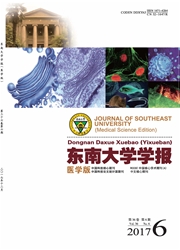

 中文摘要:
中文摘要:
The development of nanobiology requires a fundamental understanding of the interaction features between light and cells as well as cells containing nanoparticles. In this study, the generalized multiparticle Mie (GMM) theory was employed to calculate the scattering properties of cells under refractive index matching conditions. The angular distribution of scattered light is statistically averaged to obtain a good fit for the experimental results. Based on a simplified cell model, the variabilities between the scattered light pattern of normal cells and that of cancerous cells were examined. The results indicate that the small angle scattering is sensitive to the organelle distribution, which could be applied in the diagnostics of cancerous cells. Finally, the effects of cellular uptake of nanoparticles on the scattering pattern was also investigated.
 英文摘要:
英文摘要:
The development of nanobiology requires a fundamental understanding of the interaction features between light and cells as well as cells containing nanoparticles. In this study, the generalized multiparticle Mie (GMM) theory was employed to calculate the scattering properties of cells under refractive index matching conditions. The angular distribution of scattered light is statistically averaged to obtain a good fit for the experimental results. Based on a simplified cell model, the variabilities between the scattered light pattern of normal cells and that of cancerous cells were examined. The results indicate that the small angle scattering is sensitive to the organelle distribution, which could be applied in the diagnostics of cancerous cells. Finally, the effects of cellular uptake of nanoparticles on the scattering pattern was also investigated.
 同期刊论文项目
同期刊论文项目
 同项目期刊论文
同项目期刊论文
 The quasi-one-dimensional assembly of horseradish peroxidase molecules in presence of the alternatin
The quasi-one-dimensional assembly of horseradish peroxidase molecules in presence of the alternatin A facile approach to modify polypropylene flakes combining O2-plasma treatment and graft polymerizat
A facile approach to modify polypropylene flakes combining O2-plasma treatment and graft polymerizat Characterization and in vitro cellular uptake of PEG coated iron oxide nanoparticles as MRI contrast
Characterization and in vitro cellular uptake of PEG coated iron oxide nanoparticles as MRI contrast Synthesis, self-assembly and characterization of PEG-coated iron oxide nanoparticles as potential MR
Synthesis, self-assembly and characterization of PEG-coated iron oxide nanoparticles as potential MR The Surface Modification of Medical Polyurethane to Improve the Hydrophilicity and Lubricity: The Ef
The Surface Modification of Medical Polyurethane to Improve the Hydrophilicity and Lubricity: The Ef Molecular dynamics simulations of the interactions of charge-neutral PAMAM dendrimers with pulmonary
Molecular dynamics simulations of the interactions of charge-neutral PAMAM dendrimers with pulmonary Computational Investigation of Interaction between Nanoparticles and Membranes: Hydrophobic/Hydrophi
Computational Investigation of Interaction between Nanoparticles and Membranes: Hydrophobic/Hydrophi The relationship between internalization of magnetic nanoparticles and changes of cellular optical s
The relationship between internalization of magnetic nanoparticles and changes of cellular optical s Layered Assemblies of Single Crystal Gold Nanoplates: Direct Room Temperature Synthesis and Mechanis
Layered Assemblies of Single Crystal Gold Nanoplates: Direct Room Temperature Synthesis and Mechanis Preparation and characterization of water-soluble monodisperse magnetic iron oxide nanoparticles via
Preparation and characterization of water-soluble monodisperse magnetic iron oxide nanoparticles via Superparamagnetic Iron Oxide Nanoparticle-embedded Encapsulated Microbubbles as Dual Magnetic Resona
Superparamagnetic Iron Oxide Nanoparticle-embedded Encapsulated Microbubbles as Dual Magnetic Resona Effects of Proteins from Culture Medium on Surface Property of Silanes- Functionalized Magnetic Nano
Effects of Proteins from Culture Medium on Surface Property of Silanes- Functionalized Magnetic Nano Three-Dimensional Model for Determining Inhomogeneous Thermal Dosage in a Liver Tumor During Arteria
Three-Dimensional Model for Determining Inhomogeneous Thermal Dosage in a Liver Tumor During Arteria The investigation of frequency response for the magnetic nanoparticulate assembly induced by time-va
The investigation of frequency response for the magnetic nanoparticulate assembly induced by time-va Magnetically enhanced dielectrophoretic assembly of horseradish peroxidase molecules: Chaining and m
Magnetically enhanced dielectrophoretic assembly of horseradish peroxidase molecules: Chaining and m An image analysis method for quantification of hepatic perfusion based on contrast-enhanced ultrasou
An image analysis method for quantification of hepatic perfusion based on contrast-enhanced ultrasou The preparation and application of microbubble contrast agents combining ultrasound imaging and magn
The preparation and application of microbubble contrast agents combining ultrasound imaging and magn 期刊信息
期刊信息
